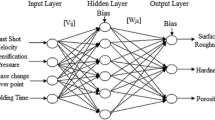Abstract
Low-pressure die-cast (LPDC) is widely used in manufacturing thin-walled aluminum alloy products. Since the quality of LPDC parts are mostly influenced by process conditions, how to determine the optimum process conditions becomes the key to improve the part quality. In this paper, a combining artificial neural network and genetic algorithm (ANN/GA) method is proposed to optimize the LPDC process. In this method, considering the more complicated preparation process of thin-walled casting, an ANN model combining learning vector quantization and back-propagation (BP) algorithm is proposed to map the complex relationship between process conditions and quality indexes of LPDC. Meanwhile, the orthogonal array design and numerical simulation is applied to obtain the training samples instead of carrying out a real experiment for the sake of cost saving. The genetic algorithm is employed to optimize the process parameters with the fitness function based on the trained ANN model. Then, by applying the optimized parameters, a thin-walled component of 300 mm in length, 100 mm in width, and 1.5 mm in thickness is successfully prepared. The results indicate that the proposed intelligent system is an effective tool for the process optimization of LPDC.
Similar content being viewed by others
References
Fu PH, Luo AA, Jiang HY, Peng LM (2008) Low-pressure die casting of magnesium alloy AM50: response to process parameters. J Mater Process Technol 205:224–234
Cleary PW (2010) Extension of SPH to predict feeding, freezing and defect creation in low pressure die casting. Appl Math Model 34:3189–3201
Zhang LQ, Li LX, Zhu BW (2009) Simulation study on the LPDC process for thin-walled aluminum alloy casting. Mater Manuf Process 24:1349–1353
Zhang B, Maijer DM, Cockcroft SL (2007) Development of a 3-D thermal model of the low-pressure die-cast (LPDC) process of A356 aluminum alloy wheels. Mat Sci Eng A 464:295–305
Wu SP, Li CY, Guo JJ (2006) Numerical simulation and experimental investigation of two filling methods in vertical centrifugal casting. T Nonferr Metal Soc 16:1035–1040
Vijayaram TR, Sulaiman S, Hamouda AMS (2006) Numerical simulation of casting solidification in permanent metallic molds. J Mater Process Technol 178:29–33
Dobrzanski LA, Krupinski M, Sokolowski JH (2005) Computer aided classification of flaws occurred during casting of aluminum. J Mater Process Technol 167:456–462
Shi HZ, Gao YH, Wang XC (2010) Optimization of injection molding process parameters using integrated artificial neural network model and expected improvement function method. Int J Adv Manuf Technol 48:955–962
Krimpenis A, Benardos PG, Vosniakos GC, Koukouvitaki A (2006) Simulation-based selection of optimum pressure die-casting process parameters using neural nets and genetic algorithms. Int J Adv Manuf Technol 27:509–517
Rai JK, Lajimi AM, Xirouchakis P (2008) An intelligent system for predicting HPDC Process variables in interactive environment. J Mater Process Technol 203:72–79
Zhang LQ, Li LX, Ju H, Zhu BW (2010) Inverse identification of interfacial heat transfer coefficient between the casting and metal mold using neural network. Energ Convers Manage 51:1898–1904
Chen CR, Ramaswamy HS (2002) Modeling and optimization of variable retort temperature (VRT) thermal processing using coupled neural networks and genetic algorithms. J Food Eng 53:209–220
Yarlagadda PKDV (2002) Development of an integrated neural network system for prediction of process parameters in metal injection molding. J Mater Process Technol 130–13:315–320
Shen CY, Wang LX, Li Q (2007) Optimization of injection molding process parameters using combination of artificial neural network and genetic algorithm method. J Mater Process Technol 183:412–418
Verran GO, Mendes RPK, Valentina-Dalla LVO (2008) DOE applied to optimization of aluminum alloy die castings. J Mater Process Technol 200:120–125
Zhang Y, Zhao SD, Zhang ZY (2008) Optimization for the forming process parameters of thin-walled valve shell. Thin Wall Struct 46:371–379
Kuo JH, Hsu FL, Hwang WS (2001) Development of an interactive simulation system for the determination of the pressure–time relationship during the filling in a low pressure die casting process. Sci Technol Adv Mat 2:131–145
Park YW, Rhee S (2008) Process modeling and parameter optimization using neural network and genetic algorithms for aluminum laser welding automation. Int J Adv Manuf Technol 61:1401–1411
Han X, Xu D, Liu GR (2003) A computational inverse technique for material characterization of a functionally graded cylinder using a progressive neural network. Neurocomputing 51:341–360
Paszkowicz W (2009) Genetic algorithms, a nature-inspired tool: survey of applications in materials science and related fields. Mater Manuf Process 24:174–197
Surekha B, Kaushik LK, Panduy AK, Vundavilli PR, Parappagoudar MB (2012) Multi-objective optimization of green sand mould system using evolutionary algorithms. Int J Adv Manuf Technol 58:9–17
Coello CAC, Becerra RL (2009) Evolutionary multiobjective optimization in materials science and engineering. Mater Manuf Process 24:119–129
Wen JL, Yang YK, Jeng MC (2009) Optimization of die casting conditions for wear properties of alloy AZ91D components using the Taguchi method and design of experiments analysis. Int J Adv Manuf Technol 41:430–439
Author information
Authors and Affiliations
Corresponding author
Rights and permissions
About this article
Cite this article
Zhang, L., Wang, R. An intelligent system for low-pressure die-cast process parameters optimization. Int J Adv Manuf Technol 65, 517–524 (2013). https://doi.org/10.1007/s00170-012-4190-4
Received:
Accepted:
Published:
Issue Date:
DOI: https://doi.org/10.1007/s00170-012-4190-4




